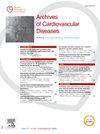Koch's triangle and coronary sinus anatomy assessed by three-dimensional electroanatomical mapping in paediatric patients with junctional tachycardia
IF 2.3
3区 医学
Q2 CARDIAC & CARDIOVASCULAR SYSTEMS
引用次数: 0
Abstract
Background
Three-dimensional electroanatomical mapping has become an essential tool in paediatric electrophysiology to precisely identify areas involved in arrhythmias. Anatomical variations in Koch's triangle, especially fluoroscopic enlargement of the coronary sinus ostium, have been found more frequently in patients with atrioventricular nodal reentrant tachycardia (AVNRT) than in those with atrioventricular reentrant tachycardia (AVRT). This finding is consistent with easier coronary sinus cannulation during electrophysiology procedures in patients with AVNRT.
Aim
To explore anatomical differences in the coronary sinus and Koch's triangle between children with AVNRT and AVRT using three-dimensional system acquisitions.
Methods
We conducted a single-centre retrospective study of paediatric patients undergoing a catheter ablation procedure for AVNRT or AVRT. Detailed anatomy of the coronary sinus ostium, global morphology and Koch's triangle properties was assessed via catheter-based intracardiac three-dimensional electroanatomical mapping, and compared.
Results
Forty-four children were enrolled (22 in each group). The median age was 14.6 (interquartile range [IQR] 10.9–16.2) years. The coronary sinus ostium area and diameter were similar in the AVNRT and AVRT groups: area, 1.0 (IQR 0.7–1.2) vs. 1.2 (IQR 0.5–1.6) cm/m2, respectively (P = 0.71; 95% confidence interval of median difference –0.3 to 0.3); diameter, 1.0 (IQR 0.8–1.5) vs. 1.1 (IQR 0.9–1.4) cm/m2, respectively (P = 0.56; 95% confidence interval of median difference –0.2 to 0.2). Five patients (22.7%) in each group had a coronary sinus with a windsock morphology. There was no difference in the Koch's triangle area between the AVNRT and AVRT groups: 1.4 (IQR 1.1–2.0) vs. 1.6 (IQR 1.3–1.9) cm2/m2, respectively (P = 0.37; 95% CI of median difference –0.2 to 0.5).
Conclusions
Our findings suggest no difference in coronary sinus anatomy between these two junctional tachycardias. A potential explanation is the limited ability of three-dimensional mapping technologies to accurately define complex intracardiac structures.

结合性心动过速患儿的科赫三角和冠状窦三维电解剖定位评估。
背景:三维电解剖制图已成为儿科电生理学精确识别涉及心律失常区域的重要工具。科氏三角形的解剖变异,尤其是冠状窦口的透视放大,在房室结状重入性心动过速(AVNRT)患者中比在房室重入性心动过速(AVRT)患者中更常见。这一发现与AVNRT患者在电生理过程中更容易进行冠状动脉窦插管一致。目的:利用三维成像技术探讨儿童AVNRT和AVRT在冠状动脉窦和科赫三角的解剖差异。方法:我们对接受AVNRT或AVRT导管消融手术的儿科患者进行了单中心回顾性研究。通过基于导管的心内三维电解剖作图评估冠状窦口的详细解剖、整体形态和科赫三角形特性,并进行比较。结果:共入组44例(每组22例)。中位年龄为14.6岁(四分位数间距[IQR] 10.9 ~ 16.2)岁。AVNRT组和AVRT组冠状窦口面积和直径相似:面积分别为1.0 (IQR 0.7-1.2)和1.2 (IQR 0.5-1.6) cm/m2 (P=0.71;中位数差的95%置信区间为-0.3 ~ 0.3);直径分别为1.0 (IQR 0.8-1.5)和1.1 (IQR 0.9-1.4) cm/m2 (P=0.56;中位数差的95%置信区间为-0.2 ~ 0.2)。两组均有5例(22.7%)冠脉窦呈风袜状。AVNRT组和AVRT组之间的科赫三角面积无差异:分别为1.4 (IQR 1.1-2.0)和1.6 (IQR 1.3-1.9) cm2/m2 (P=0.37;中位差的95% CI为-0.2 ~ 0.5)。结论:我们的研究结果表明这两种结缔性心动过速的冠状窦解剖无差异。一种可能的解释是三维制图技术在精确定义复杂的心内结构方面的能力有限。
本文章由计算机程序翻译,如有差异,请以英文原文为准。
求助全文
约1分钟内获得全文
求助全文
来源期刊

Archives of Cardiovascular Diseases
医学-心血管系统
CiteScore
4.40
自引率
6.70%
发文量
87
审稿时长
34 days
期刊介绍:
The Journal publishes original peer-reviewed clinical and research articles, epidemiological studies, new methodological clinical approaches, review articles and editorials. Topics covered include coronary artery and valve diseases, interventional and pediatric cardiology, cardiovascular surgery, cardiomyopathy and heart failure, arrhythmias and stimulation, cardiovascular imaging, vascular medicine and hypertension, epidemiology and risk factors, and large multicenter studies. Archives of Cardiovascular Diseases also publishes abstracts of papers presented at the annual sessions of the Journées Européennes de la Société Française de Cardiologie and the guidelines edited by the French Society of Cardiology.
 求助内容:
求助内容: 应助结果提醒方式:
应助结果提醒方式:


